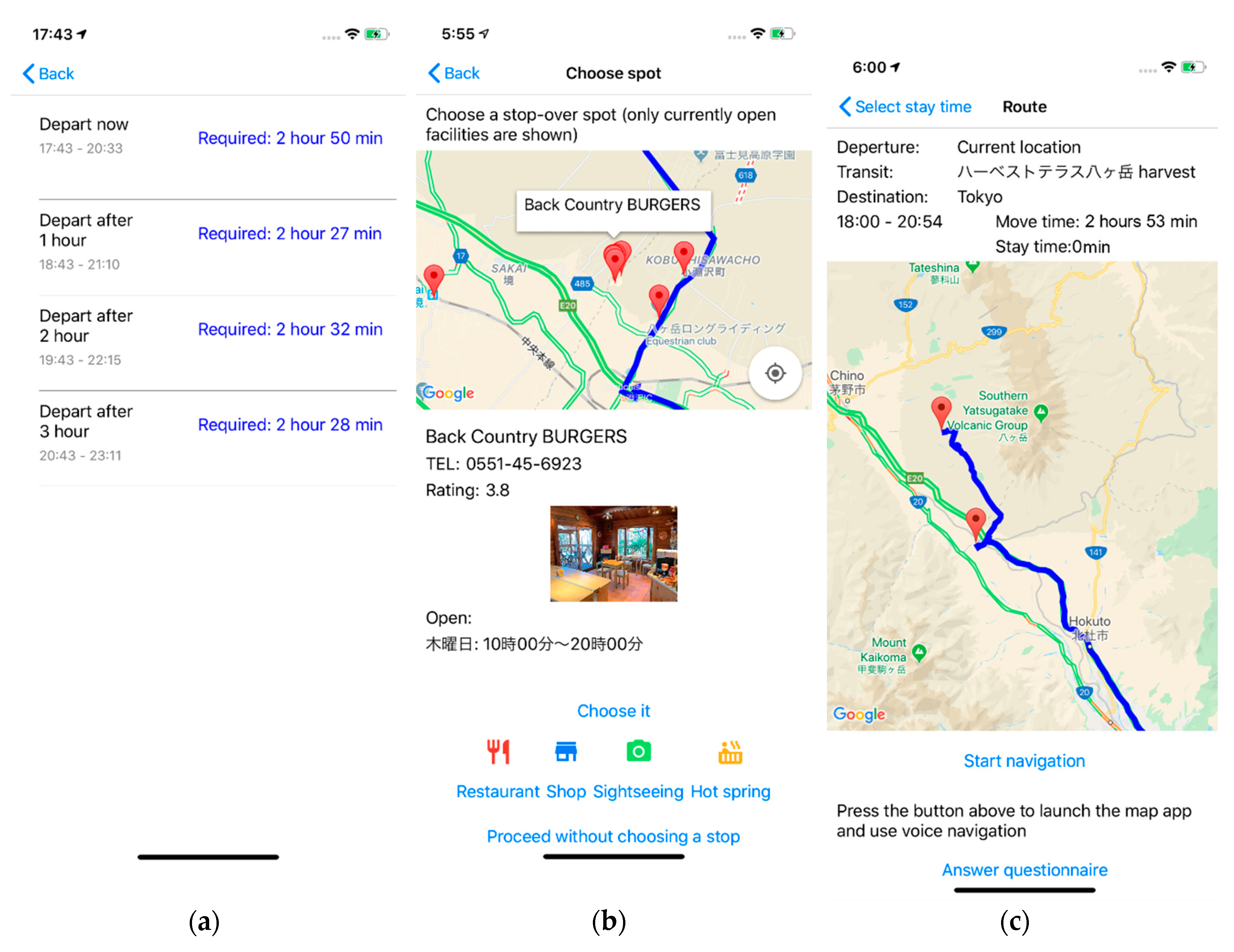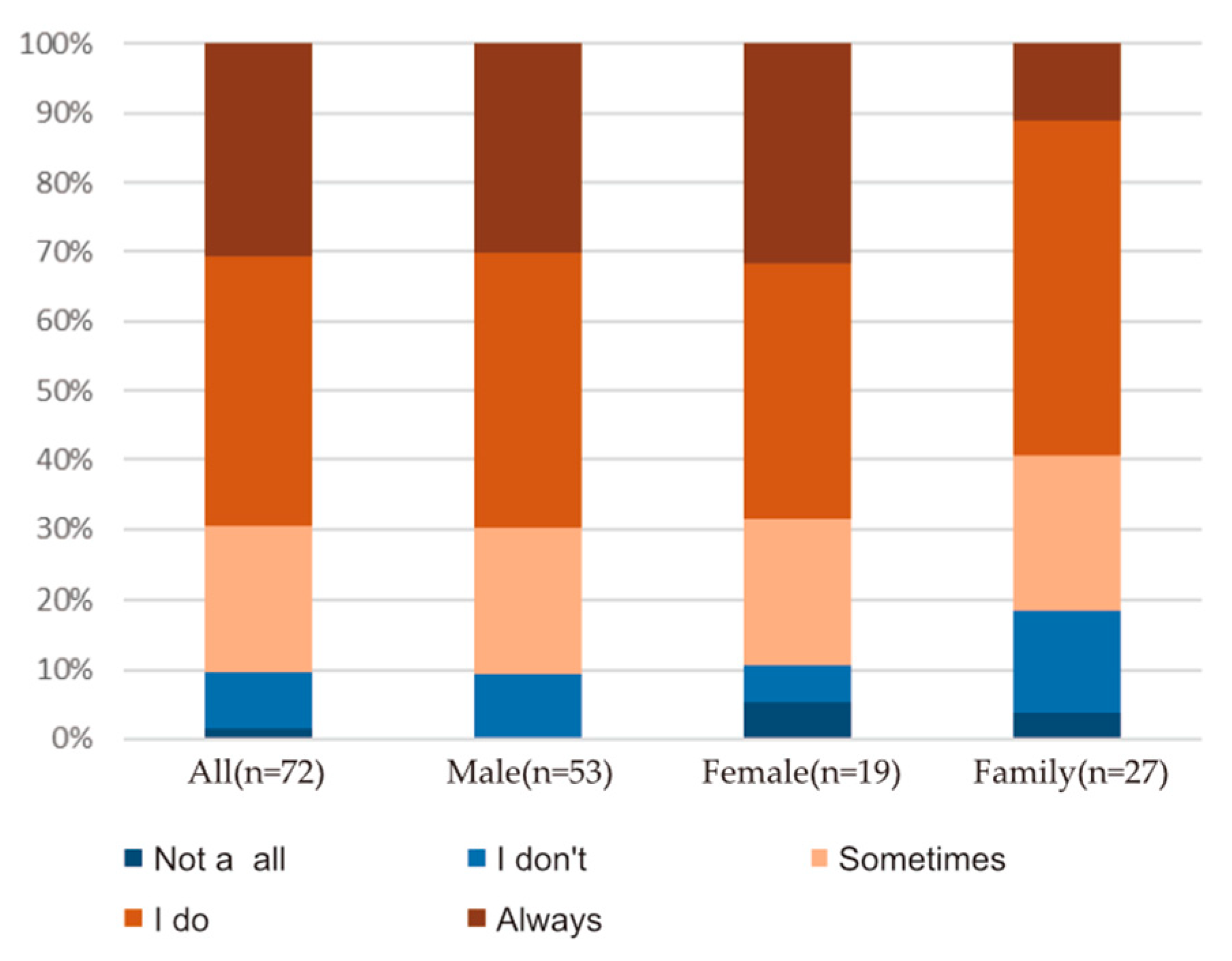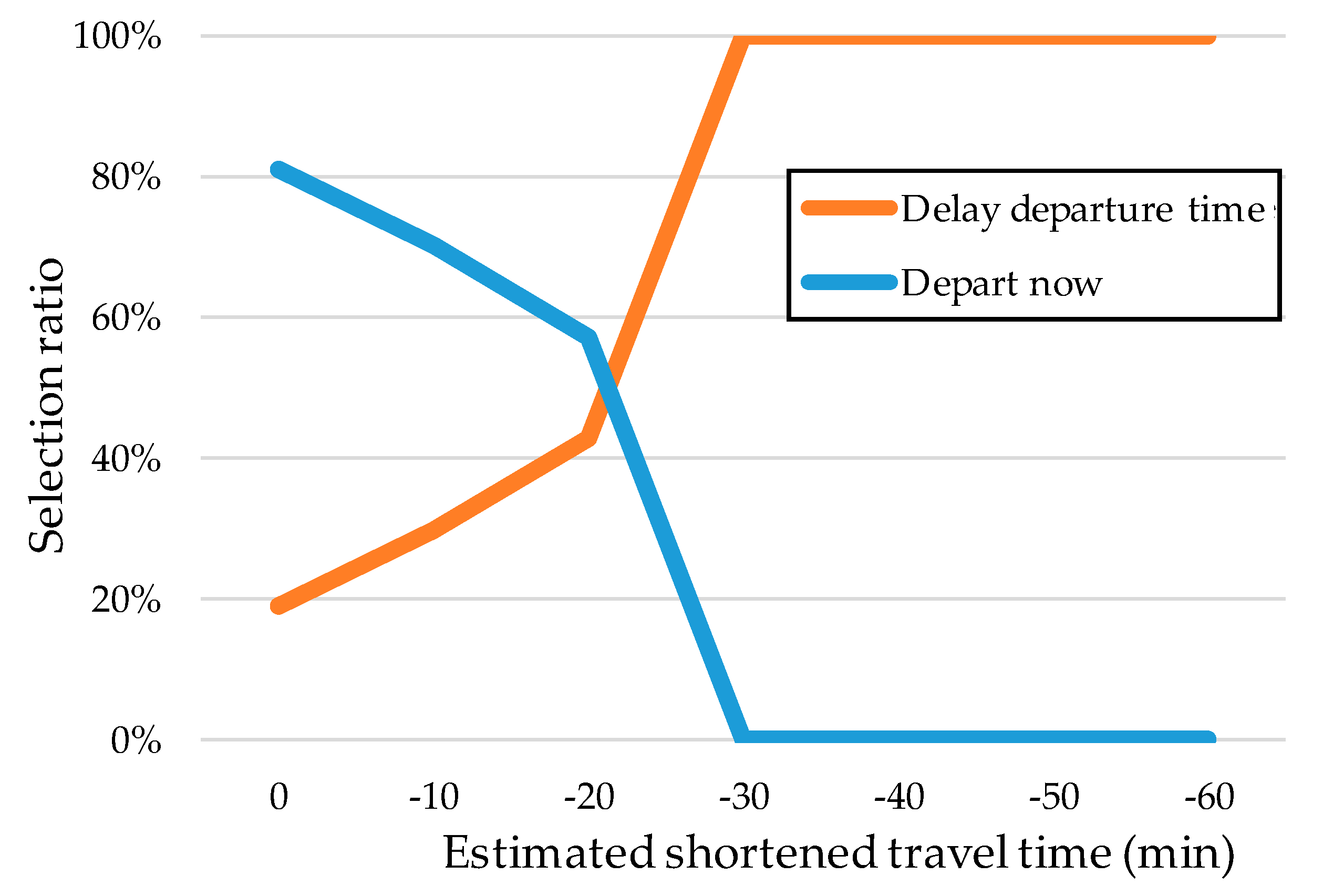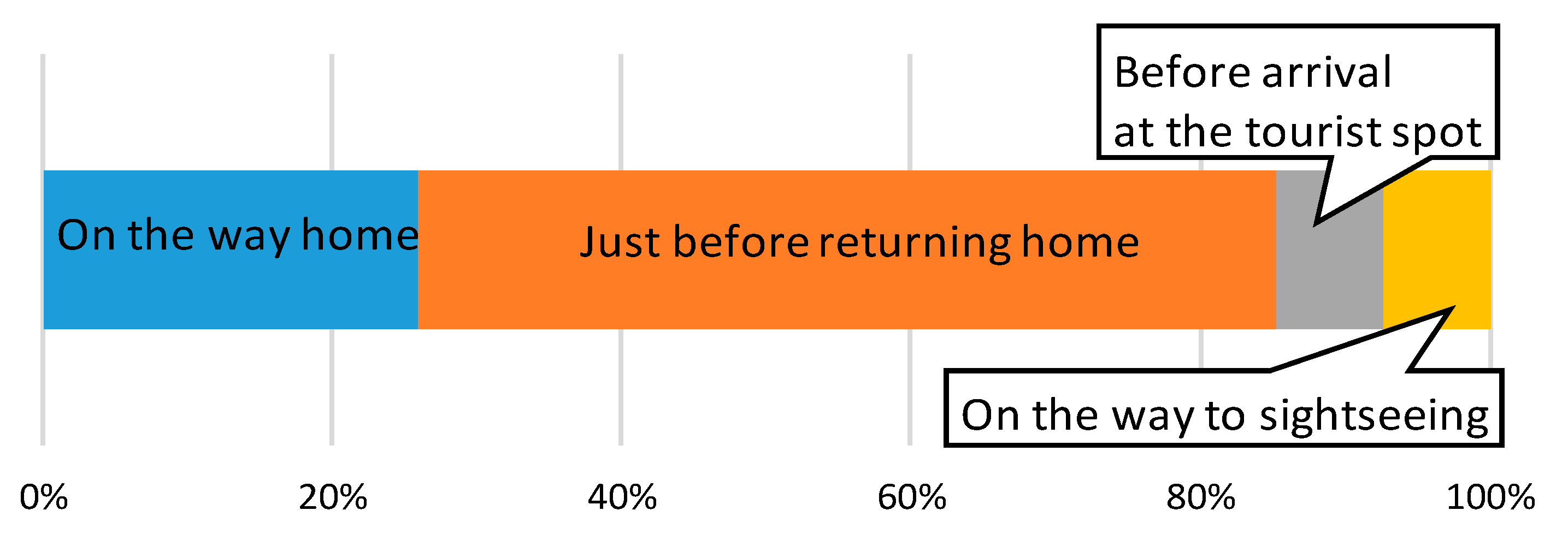Mobile Application to Provide Traffic Congestion Estimates and Tourism Spots to Promote Additional Stopovers
Abstract
1. Introduction
2. Related Work
3. Methods
3.1. Experimental Overview
3.2. Application Requirements
3.3. Application Use and Data Acquisition Flow
3.4. Application Implementation
4. Results and Discussion
4.1. Participants
4.2. Analysis of App Operations Logs
4.3. Analysis of Questionnaire Results and Travel Trajectory
5. Conclusions
Author Contributions
Funding
Acknowledgments
Conflicts of Interest
References
- Kuwahara, M. The science of traffic congestion. Noise Control 2003, 27, 431–436. (In Japanese) [Google Scholar]
- Central Nippon Expressway Company. Chuo Expressway Congestion Relief Working Group Survey. 2007; (unpublished). (In Japanese) [Google Scholar]
- Zhao, J.; Freeman, B.; Li, M. Can mobile phone applications influence people’s health behavior change? An evidence review. J. Med. Internet Res. 2016, 18, e287. [Google Scholar] [CrossRef] [PubMed]
- Conroy, D.E.; Yang, C.; Maher, J.P. Behavior change techniques in top-ranked mobile applications for physical activity. Am. J. Prev. Med. 2014, 46, 649–652. [Google Scholar] [CrossRef] [PubMed]
- Gabrielli, S.; Maimone, R.; Forbes, P.; Masthoff, J.; Wells, S.; Primerano, L.; Haverinen, L.; Bo, G.; Pompa, M. Designing motivational features for sustainable urban mobility. In CHI ’13 Extended Abstracts on Human Factors in Computing Systems, Paris, France, 2013; ACM Press: New York, NY, USA, 2013; pp. 1461–1466. [Google Scholar] [CrossRef]
- Siuhi, S.; Mwakalonge, J. Opportunities, and Challenges of Smart Mobile Applications in Transportation. J. Traffic Transp. Eng. 2016, 3, 582–592. [Google Scholar] [CrossRef]
- Le, Y.; Aoyagi, S.; Takahashi, K. Understanding additional stopover behaviors of car tourists: An analysis of combined route search and mobile GPS travel trajectory data. In Proceedings of the 4th International Conference on Intelligent Transportation Engineering (ICITE 2019), Singapore, 5–7 September 2019. [Google Scholar] [CrossRef]
- Hallo, J.C.; Beeco, J.A.; Goetcheus, C.; McGee, J.; McGehee, N.G.; Norman, W.C. GPS as a Method for Assessing Spatial and Temporal Use Distributions of Nature-Based Tourists. J. Travel Res. 2012, 51, 591–606. [Google Scholar] [CrossRef]
- Li, J.; Xu, L.; Tang, L.; Wang, S.; Li, L. Big data in tourism research: A literature review. Tour. Manag. 2018, 68, 301–323. [Google Scholar] [CrossRef]
- Hallo, J.C.; Manning, R.E.; Valliere, W.; Budruk, M. A Case Study Comparison of Visitor Self-reported and GSP Recorded Travel Routes. In Proceedings of the Northeastern Recreation Research Symposium 2004—GTR-NE-326, Newtown Square, PA, USA, 31 March–2 April 2005; pp. 172–177. [Google Scholar]
- Connell, J.; Page, S.J. Exploring the spatial patterns of car-based tourist travel in Loch Lomond and Trossachs National Park, Scotland. Tour. Manag. 2008, 29, 561–580. [Google Scholar] [CrossRef]
- Newton, J.N.; Newman, P.; Taff, B.D.; D’Antonio, A. Spatial-temporal dynamics of vehicle stopping behavior along a rustic park road. Appl. Geogr. 2017, 88, 94–103. [Google Scholar] [CrossRef]
- Froehlich, J.; Tawanna, D.; Predrag, K.; Mankoff, J.; Consolvo, S.; Beverly, H.; Landay, J.A. UbiGreen: Investigating a mobile tool for tracking and supporting green transportation habits, In Proceedings of the 27th International Conference on Human Factors in Computing Systems—CHI 09, Boston, MA, USA, 4–9 April 2009; ACM Press: New York, NY, USA, 2009. [CrossRef]
- Aoyagi, S.; Okamura, T.; Ishii, H.; Shimoda, H. Proposal, and evaluation of a method for promoting continuous pro-environmental behavior with moderate communication. Pap. Hum. Interface Soc. 2011, 13, 31–44. (In Japanese) [Google Scholar]
- Sigalert.com. Available online: https://apps.apple.com/us/app/sigalert-com-live-traffic-reports/id424889327 (accessed on 24 March 2020).
- 511 Georgia & Atlanta Traffic. Available online: https://apps.apple.com/us/app/511-georgia-atlanta-traffic/id584675609 (accessed on 24 March 2020).
- Colorado Roads. Available online: https://play.google.com/store/apps/details?id=com.cdot.mobile (accessed on 24 March 2020).
- Suisui-tabi. Available online: https://www.suisuitabi.org (accessed on 21 January 2020).
- Ministry of Land, Infrastructure, Transport and Tourism, City Bureau, City Planning Survey and Information Office: Movement People in Cities and Its Changes—From Nationwide Traffic Characteristics Survey 2015-. Available online: https://www.mlit.go.jp/report/press/toshi07_hh_000117.html (accessed on 24 March 2020). (In Japanese).







| Attributes | Number | Percentage | |
|---|---|---|---|
| Gender | Male | 53 | 73.6% |
| Female | 19 | 26.4% | |
| Age | 20s | 8 | 11.1% |
| 30s | 17 | 23.6% | |
| 40s | 19 | 26.4% | |
| 50s | 19 | 26.4% | |
| 60s | 8 | 11.1% | |
| 70s or more | 1 | 1.4% | |
| Companion | Traveling alone | 7 | 9.7% |
| Family with children | 30 | 41.7% | |
| Family without children | 27 | 37.5% | |
| Friends | 7 | 9.7% | |
| Others | 1 | 1.4% | |
| Purpose of travel | Sightseeing | 56 | 77.8% |
| Homecoming/visiting friends | 11 | 15.3% | |
| Business | 0 | 0.0% | |
| Others | 5 | 6.9% |
| Operation Type | Number of Operations | Number of Operators | Average Number of Operations |
|---|---|---|---|
| Route search | 907 | 60 | 15.12 |
| Route choice | 234 | 58 | 4.03 |
| Spot check | 341 | 57 | 5.98 |
| Spot choice | 144 | 14 | 10.29 |
| Route check | 19 | 9 | 2.11 |
| Participant | Probe Data Recorded | Shortened Travel Time Min) | Chosen Option in the Application’s Operation Logs | Actual Behavior | Consistency of Chosen Option and Actual Behavior |
|---|---|---|---|---|---|
| #1 | Yes | 2.5 | Depart now | No stopover | Yes |
| #2 | Yes | 22.1 | Depart later | Additional stopover | Yes |
| #3 | No data | 3.3 | Depart later | Additional stopover | Yes |
| #4 | Yes | 1.3 | Depart now | No stopover | Yes |
| #5 | Yes | 2.2 | Depart now | No stopover | Yes |
| #6 | Yes | 26.9 | Depart later | Additional stopover | Yes |
| #7 | Yes | 10.4 | Depart now | No stopover | Yes |
| #8 | Yes | 4.6 | Depart later | Additional stopover | Yes |
| #9 | Yes | 1.5 | Depart later | No stopover | No |
| #10 | No data | 4.1 | Depart now | Additional stopover | No |
| #11 | No data | 6.2 | Depart now | No stopover | Yes |
| #12 | Yes | 16.7 | Depart now | No stopover | Yes |
© 2020 by the authors. Licensee MDPI, Basel, Switzerland. This article is an open access article distributed under the terms and conditions of the Creative Commons Attribution (CC BY) license (http://creativecommons.org/licenses/by/4.0/).
Share and Cite
Aoyagi, S.; Le, Y.; Shimizu, T.; Takahashi, K. Mobile Application to Provide Traffic Congestion Estimates and Tourism Spots to Promote Additional Stopovers. Future Internet 2020, 12, 83. https://doi.org/10.3390/fi12050083
Aoyagi S, Le Y, Shimizu T, Takahashi K. Mobile Application to Provide Traffic Congestion Estimates and Tourism Spots to Promote Additional Stopovers. Future Internet. 2020; 12(5):83. https://doi.org/10.3390/fi12050083
Chicago/Turabian StyleAoyagi, Saizo, Yiping Le, Tetsuo Shimizu, and Kazuki Takahashi. 2020. "Mobile Application to Provide Traffic Congestion Estimates and Tourism Spots to Promote Additional Stopovers" Future Internet 12, no. 5: 83. https://doi.org/10.3390/fi12050083
APA StyleAoyagi, S., Le, Y., Shimizu, T., & Takahashi, K. (2020). Mobile Application to Provide Traffic Congestion Estimates and Tourism Spots to Promote Additional Stopovers. Future Internet, 12(5), 83. https://doi.org/10.3390/fi12050083





